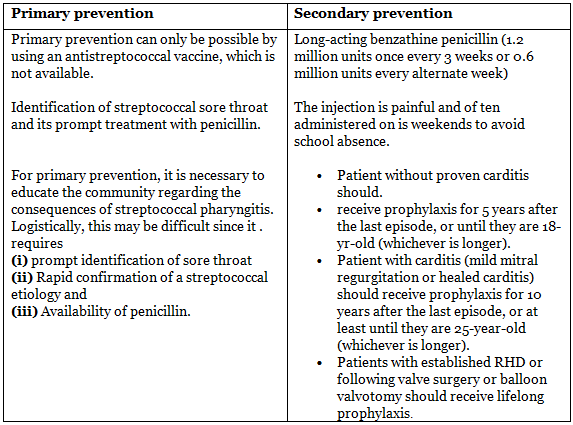Rheumatic Heart Disease (RHD) | Medical Science Optional Notes for UPSC PDF Download
| Table of contents |

|
| RF - Etiology |

|
| RF - Pathogenesis |

|
| RF - Jones Criteria |

|
| RF - Prevention |

|
RF - Etiology
- The cause of rheumatic fever remains unidentified.
- A notable correlation is observed with beta-hemolytic streptococci of group A.
After a streptococcal sore throat, there is a latent period ranging from 10 days to several weeks before the onset of rheumatic fever. Streptococci have not been identified in rheumatic lesions affecting joints, the heart, or the bloodstream. Rheumatic fever seems to arise from an atypical host response at both the cellular and humoral levels to Streptococci.
Depending on M protein Streptococcus is classified into
- Strains that induce rheumatic fever (1, 3, 5, 6, 14, 18, 19, 24).
- Strains associated with post-streptococcal glomerulonephritis, causing nephrotogenic effects (Throat-1, 4, 12; Skin-49, 55, 57, 60).
RF - Pathogenesis

Molecular Mimicry
Antibodies capable of reacting with human connective tissue may be triggered by both streptococcal cell wall proteins and carbohydrates.

Histopathology

RF - Jones Criteria
Interpretation
Diagnosis requires two major criteria or one major criterion plus two minor criteria.
Essential Criteria
Evidence of a previous infection with group A beta-hemolytic streptococci (recent scarlet fever, elevated antistreptolysin O or other streptococcal antibody titers, or a positive throat culture).
Major Criteria:
- Arthritis (migratory polyarthritis primarily affecting large joints)
- Carditis (pancarditis, including valvulitis)
- Sydenham chorea (Involuntary, irregular, nonrepetitive movements of the limbs, neck, head, and/or face, sometimes asymmetrical or confined to one side - hemichorea)
- Subcutaneous nodules
- Erythema marginatum (Centrifugally expanding pink or light red rash with a well-defined outer border - erythema marginatum → marginated rash - and central clearing.)
Minor Criteria:
- Arthralgia
- Fever
- Increased acute phase reactants (ESR, CRP)
- Prolonged PR interval on electrocardiogram
Revised Jones Criteria (2015)
In the updated Jones criteria for low-risk populations:
- The incidence is less than 2 per 100,000 in school-going children.
- The incidence of rheumatic heart disease is less than 1 per 1,000.
Major Criteria:
- Carditis (clinical and/or subclinical)
- Arthritis (polyarthritis)
- Chorea
- Erythema marginatum
- Subcutaneous nodules
Minor Criteria:
- Polyarthralgia
- Fever (≥38.5°C/101.3°F)
- Sedimentation rate ≥60 mm and/or C-reactive protein (CRP) ≥3.0 mg/dl
- Prolonged PR interval (unless carditis is a major criterion)
Updated Jones criteria for populations at moderate and high risk:
Major Criteria:
- Carditis (clinical and/or subclinical)
- Arthritis (monoarthritis, polyarthritis, or polyarthralgia)
- Chorea
- Erythema marginatum
- Subcutaneous nodules
Minor Criteria:
- Monoarthralgia
- Fever (≥38°C/100.4°F)
- Sedimentation rate ≥30 mm and/or CRP ≥3.0 mg/dL
- Prolonged PR interval (unless carditis is a major criterion)
Interpretation
For the initial episode of acute rheumatic fever in all populations, the diagnosis requires either two major criteria or one major criterion plus two minor criteria.
For recurrent episodes of acute rheumatic fever, the diagnosis necessitates either two major criteria, one major criterion plus two minor criteria, or three minor criteria.
RF - Prevention

RHD - Repeats
- Discuss the aetiopathogenesis and pathological lesions of rheumatic fever (2000).
- Discuss the etiology, sequelae and complications of Rheumatic fever.
What are the short and long-term measures taken in the prevention of Rheumatic heart disease (2002)? - Give the incidence, pathogenesis gross and microscopic features of Rheumatic heart disease. (2012)
- What are the major and minor criteria of rheumatic fever?
Give the pathology and sequelae of rheumatic carditis. (2015)
|
7 videos|219 docs
|
FAQs on Rheumatic Heart Disease (RHD) - Medical Science Optional Notes for UPSC
| 1. What is the etiology of Rheumatic Heart Disease (RHD)? |  |
| 2. What is the pathogenesis of Rheumatic Heart Disease (RHD)? |  |
| 3. What are the Jones Criteria used for in the diagnosis of Rheumatic Heart Disease (RHD)? |  |
| 4. How can Rheumatic Heart Disease (RHD) be prevented? |  |
| 5. Is Rheumatic Heart Disease (RHD) curable? |  |

|
Explore Courses for UPSC exam
|

|
















